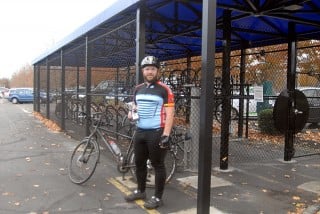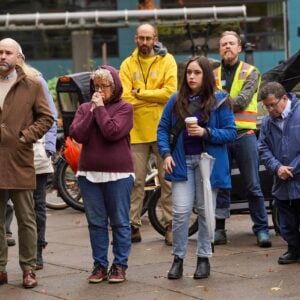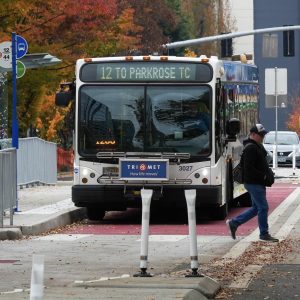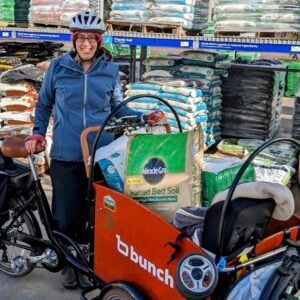An article published today by the Portland-based magazine Oregon Business takes a look at a handful of local bike-commuting superstars who regularly pedal 20 to 40 miles each way to work and back.
Biking fans won’t find many surprises in the piece, though that doesn’t diminish the accomplishment of interviewees like Kyle Carlson, a recent Friday Profile subject here at BikePortland who bikes 39 miles from Hillsboro to North Portland and back several times a week.
But one passage in the post is a little unfamiliar in Portland’s transportation conversation these days. It’s the simple but (for some reason) rarely discussed fact that if Portland doesn’t decrease the percentage of trips that happen by car, everybody who actually needs to get around by car or truck is going to be screwed.
Advertisement
From the piece’s interview with Jason Gast, a 48-mile-a-day Portland-to-Hillsboro bike commuter:
“Washington County is doing a lot to make lanes safer. But for a lot of folks they would be scared,” says Gast. He has done this commute for the past five years and noticed more cars on the road as well as more cyclists. Gast chooses to commute to work partly because he finds road traffic so frustrating. “The traffic situation in our area is not getting any better,” he says. “I can never see myself being a car commuter.”
Portland’s population is expected to grow by 280,000 in the next decade, creating a transportation headache for city planners. The Portland Bureau of Transportation is heading an initiative to create a network of biking and pedestrian trails in Portland city center and the central eastside to encourage people to commute by bike and public transit instead of driving.
Again, people already attuned to Portland transportation policy are not going to be gobsmacked by this revelation. Which is exactly why it’s so odd that “when biking is easy, it makes driving easier too” is so absent from our civic conversation.
I got home a few hours ago from a two-week vacation in Colombia (more on that in the next couple days) and it was as intense a reminder as I’ve had of the cost drivers face in cities that are rapidly adding residents but not investing in space-efficient transportation infrastructure like bike facilities and mass transit. Though many people in and around Portland seem open to the concept that if you hate congestion you should love bicycles, it’s not an idea we often hear from most local leaders. In fact, our region’s organized business advocates and some suburban politicians often seem fixated on the fantasy of perpetual automobile capacity. Hopefully some of those folks — or at least the generation that’s slowly moving in to succeed them — are reading Oregon Business.
Thanks for the tip to reader Todd B.








Thanks for reading.
BikePortland has served this community with independent community journalism since 2005. We rely on subscriptions from readers like you to survive. Your financial support is vital in keeping this valuable resource alive and well.
Please subscribe today to strengthen and expand our work.
“…if you hate congestion you should love bicycles…”
That’s a good slogan.
It’s a concept that’s even easier to grasp than “One Less Car”.
And less divisive.
Agreed, “One Less Car” always confused me. Is it, “you should appreciate that you aren’t sitting behind me in a car?” or “I’m better than you because I’m not in a car” or what?
Maybe it is you should appreciate my poor grammar
You SHOULD.
Don’t you mean: One Car Fewer ?
I mean “n – 1 cars, where n is the number of cars on the road if I were also driving one”. I’m putting that on a T-shirt.
“If I was in a car, I would be in your way right now.”
“were” is grammatically correct. I would wear the t-shirt, but “not part of the problem” might be more straightforward if it isn’t read as condescending by those who feel guilty for not riding a bike.
The problem with “biking makes driving easier” is the tendency with this sort of commons to say “Great! You bike, and I’ll drive!”
$16/gal gasoline makes driving easier too, and might even be near a fair share.
“The problem with ‘biking makes driving easier’ is the tendency with this sort of commons to say ‘Great! You bike, and I’ll drive!'”
Bingo!
“$16/gal gasoline makes driving easier too, and might even be near a fair share.”
I’ll put that on a T-shirt.
Agreed. It really should read: “One, Less Car.”
Welcome back, Michael.
“if Portland doesn’t increase the share of people choosing not to use cars, everybody who actually needs to get around by car is going to be screwed.”
Constraints! Now how about that?
ODOT’s SW Farmington Road will get 7 lanes at the SW Murray Blvd intersection for 2017. Who wants to enjoy that bigger crosswalk? The all-new bike lanes, will be 6 feet wide and the sidewalks will be 8 feet wide.
I think that section of Farmington is under Washington County jurisdiction, not ODOT.
Sounds like a huge waste of space. Everything would be better and more manageable if there weren’t only dead ends and deadly roads.
Enjoy riding on the country roads in Washington County before they all get turned into arterials.
That’s the unfortunate thing…they are already there.
I told Kim, Evergreen, Cornell, Cornelius Pass, Baseline, Murray, Farmington, etc., all have “Street” or “Road” after them. But, these roads act more like highways than roads.
In WashCo., the roads are getting wider and the cars are going faster (which scares the hell out of a beginning cyclist). The new roads are getting bike lanes, but the establishment of true separation of cars and bikes is not happening, outside of the sporadic use of a buffer lane.
Hwy 219 (beautiful back country route from Hillsboro that connects to the Beaverton, Sherwood and Newberg areas) is getting a huge chunk of the road repaved, but do you think they’d pave out enough to truly provide cyclists adequate space? Nope. And 219 is widely used by cyclists as it’s a beautiful ride.
Kaiser and Springville are next.
…There’s still Old Germantown…at least for going up the hill. But even on an arterial Springville, I’d bet a bicycle could beat a car down from Skyline on those curves…
“…I told Kim, Evergreen, Cornell, Cornelius Pass, Baseline, Murray, Farmington, etc., all have “Street” or “Road” after them. But, these roads act more like highways than roads. …” Justin Gast
I’m glad you made an effort to raise the issue of relatively quiet country roads having been converted to high volume, high speed thoroughfares. 185th is another formerly neighborhood friendly, bike friendly road that’s been converted to a mean, stressful road to use. I hear of word that 170th is also subject to conversion to higher capacity.
What I wonder, is whether there is any way for this approach to accommodating growing need for road use, to be changed to something different, less motor vehicle dependent, that for example, Washington County residents, business, and leaders would support. During rush hour, for years, highways and thoroughfares have literally been at capacity, bumper to bumper slow moving traffic. Terrible.
Words like ‘cycle track’ are popular buzz words in some quarters, but around here, it does not seem that the concept the words refer to is yet seriously explored as a viable means of helping to meet the extraordinary and increasing demands for travel on area roads.
On Swan Island the TMA encourages employees to bike, walk and use transit, SO THAT parts, products (aka Freight), and people that need to use the motor vehicle lanes can! It is a no-brainer and a win for all.
Or put another way…”I can be in my car in front of you or on my bike beside you in the bike lane!” Which is it? Hello!
For everyone who needs to use a motor vehicle, all us bikers, transit riders, walkers are your FRIENDS! We are helping you out!
Sorry for all the “!!!” and CAPs, but this is so obvious it hurts.
Welcome home, Michael, and congrats!
And yet drivers on Swan Island are the most hostile bike-hating group in the city. They HATE you if you are on two wheels down there.
“…the cost drivers face in cities that are rapidly adding residents but not investing in space-efficient transportation infrastructure…”
“Space-efficient”. This is a key point that takes a seemingly inexplicable back seat to “Climate Change!”, and “Peak Oil!”. Many cities hit “Peak Space” many years ago. It doesn’t matter whether your car runs on oil, electricity, or dog poop—you still have to be able to cram it onto the road and into a parking space.
Dog poop powered car…
Its the next step after french fry oil got hard to find.
BTW, I might have titled this post “More Biking=Better Driving Conditions“. I was expecting a story about how drivers behave better when there are more people on bikes…
Good point.
But thinking on this a bit more, we should not be in the business of championing better driving conditions because in the big picture there is nothing about improved driving conditions worth celebrating. To do so is to take a hopelessly outdated, short term view of our transportation future. This kind of thinking reminds me of the occasional calls here for people caught driving drunk or carelessly to be punished by riding a bike for a month or a year. Yikes.
we can’t improve driving conditions because those conditions vary by person… many people think that wide open space to move freely is an improvement… when I’m driving I want a single lane with few options to be able to confuse and hinder… if a route requires me to merge across a lane to get to my street then it’s not a good driving condition for me… I’d rather go 20 mph on a single lane street than 40 mph on a multi lane street that requires multiple lane changes and merges to continue along my route…
The same is true for bike infrastructure. Comments posted to these blog posts show the wide range of opinions about what bike infrastructure is “needed.”
I wouldn’t suggest championing anything like that, but the article just seems to be about that.
I wonder whether a strange kind of “induced demand” would arise if enough people start using alternatives. If driving conditions become too good due to people riding, would people start getting off the bus and the saddle to get back in the car?
Another scenario would be that driving, like in ye olden dayes, becomes the purview of the super-rich, like owning a private jet nowadays. If you think driver entitlement is bad now…
“If driving conditions become too good due to people riding, would people start getting off the bus and the saddle to get back in the car?”
A real concern. Which is why we should be shrinking the lane miles available to those (still) in cars all the while.
Or alternatively, “Spending more time on a bike makes you a more attentive driver.”
In fact, it can make you better at it than driving does.
I fully concur.
Me too! Was thinking the same thing as I read this–it’s true!
Also true! Good post idea.
Like El Biciclero, I expected something slightly different, and now that I mention it, wonder whether it is true: that drivers who bike are more skillful, safer, at driving than those who don’t (or perhaps than themselves when they didn’t). I wonder whether this has been studied.
That’s almost what I was expecting to see: when more people ride bikes, then it stands to reason that more drivers are also bike riders, and that therefore, more drivers have empathy for the bicycling public and drive accordingly.
This would also be a welcome effect of more bicycling, as far as I’m concerned.
Isn’t this pretty much what we know to be the case in Western European countries? = Natural experiment?
It’s great that you’re starting attention to this obvious correlation, but disappointing that you’re neglecting to mention a solution that would address this issue with incredible efficacy: bike-only streets.
Five “bike highways”, running east-west, with two north-south connectors would address
– safety (obv)
– economic development (imagine Harold as a bike-only road)
Hit post to soon.
Culture – “Share the Road” has failed. Ask any regular commuter following the rules of road. You can’t win. And neither can cars. A top speed of 20mph shouldn’t be on a 35mph right of way, and a frantic parent with a sick child shouldn’t be in a 20mph residential street.
Cost – How much do bollards, every three blocks, on one side of a two way street cost? How much has Vancouver/Williams cost?
Big picture – Bike infrastructure might be a drop in the bucket for global climate trends but considering that recent scientific estimates (20ft sea rise) will put Sauvie Island underwater, I think it’s time to stop “cooperating” and get real. I drive. But very little. We need to do everything possible, RIGHT NOW, to make this shift. Making it harder to drive is where we need to be going. Bike-only streets are the right thing, right now.
There is no hope for the poor souls who live In Hillsboro and work downtown. Washington county is already a vast expanse of congested, super-wide highways that are only being redesigned even wider. It’s already screwed. I don’t know why Washington County thinks it can keep living in the 1950s, but there’s no end in sight.
Right? I always tell people that every person who bikes instead of drives is one less person in traffic that you’re stuck behind.
https://docs.google.com/forms/d/1hpbvZ-4-BuTDeTGtVzOFCRO9MVzkswVQOs-PxyBrS-Q/viewform?usp=send_form
you SHALL love bicycles
Believe it or not there are people who would rather have people be in cars than on bikes. They think that bikes hold up traffic and bike infrastructure siphons precious resources and space away from “much needed road improvements.” (rolls eyes)
I think of these people as “crazy people.”
I just think of them as unevolved. Where they are now, I have been.
“mathematically challenged”
Exactly. Which is why places like Atlanta are such a driving paradise.
“Believe it or not there are people who would rather have people be in cars than on bikes. They think that bikes hold up traffic and bike infrastructure siphons precious resources and space away from “much needed road improvements.” …” Tony T
People that drive well, think also, about situations where persons riding don’t stick to safe road use procedures, consequently contributing to a major potential for a collision. There’s virtually no required instruction, training, or testing requirements set up for people taking to the road with a bike, unless…they’ve gone through the procedure to get a driver’s license; which the word is…that fewer people are interested in going through.
Vulnerable road users riding bikes, unskilled in safely riding bikes amongst motor vehicles, undermines potential growth for public investment in better infrastructure for biking.
Mandatory licensing would probably increase the injuries per mile by reducing the number of people biking. And given the behavior we see from drivers (presumably with mandatory licenses), it might not change the behaviors much.
What I would like to see is an optional certification with some compelling benefits attached — maybe it gets you a pass on driver’s ed and/or priority at the DMV. Some way to make people want to learn the bike laws and even take a driving test on a bike — so many drivers just haven’t ever ridden in the street (not even as kids?)
As much as I would like this to be true, I don’t believe it really will be until the mode share gets up to 25%. We all know that adding lanes doesn’t relieve congestion for long. The same thing should happen if you divert 8 to 10% of the congestion to bicycles or other modes. Pent up demand will casue the increase in capacity to be filled and you will wind up with the same amount of congestion. Now, if you can increase capacity enough, you should be able to satisfy that pent up demand and reduce congestion, but it would take a significant change in mode share to do that.
The people I’ve talked to who drive cars don’t see it that way. They’re usually afraid more biking equals more road dieting, less travel lanes, and more obstacles along their drive…
What they don’t realize is if there is only one lane, they don’t need to zigzag between lanes. They only have one obstruction. The car ahead of them. Just smile at them as you ride by while they are in gridlock.
I’ve mentioned this before, but Seattle’s venerable R&E Cycles used to print jersies that said “One More Parking Space.”
I’m SO glad that you wrote this article, Michael! More people biking = fewer people driving. Europe takes this premise even further: very few car drivers = better biking AND driving! Cycling is an unimaginable joy in many cities in Europe, but it often doesn’t have to do with the percentage of cyclists or even the quality of the cycling infrastructure in many cases. Rather, the reason cycling is so wonderful in many European cities is very simple: there are very few cars on their streets!
Driving is simply discouraged (due partly to space but mainly due to the the great policy of passing on the REAL cost of owning and driving cars to their owners). Thus, people find other ways to get around. I was actually told *not* to bike in Prague because “no one bikes in Prague” (and they have almost zero “cycling” infrastructure). However, biking there was EPIC because almost no one drives cars or rides bikes; nearly everyone walks or takes the very fast and reliable trams everywhere. Thus, I biked blissfully down every single street in Prague.
Granted, it will take a number of MAJOR steps in Portland (and nationally, which is even more of a challenge) to dramatically increase the bicycle mode split: 1. We need to price car ownership, parking and driving appropriately (including the price of gas). 2. We need a MUCH more densely populated city (it is utterly embarrassing to see how suburban and wasteful with space we are after visiting a city of literally any size in Europe) so that people aren’t living 30 miles from where they work! And density can easily be doubled through encouraging “missing middle” housing (duplexes, ADUs, several-story buildings along major retail corridors, taller buildings near transit stations, etc). 3. We’ve GOT to (quickly, where we ask for forgiveness rather than permission–or, worse yet, continue to go through the dreaded “Portland Process”) build out the safe cycling network that we’ve been wanting for decades (i.e., infrastructure safe enough to encourage the “interested but concerned” hyper-majority to actually bike to work for once–or school, or the store, etc). Do like Better Blocks PDX did–make this stuff happen now! City Council will follow; they’re clearly not leaders, as we’ve seen for years now.
4. But most of all (echoing what I saw everywhere in Copenhagen), we need to *immediately* reclaim street space for cycling! This is, paradoxically, by far the easiest thing we can do right now. The streets are already built out, after all (and Portland has nearly the highest percentage of land devoted to streets of ANY city in the U.S., large or small!!). We devote far, FAR too much of street space to cars in Portland. Just start removing full lanes right *now*. We’ll save $billions in long-term infrastructure costs, too, as a little side benefit. 🙂 Not to mention vastly improved health, quality of life, etc…
95% of the streets in Copenhagen have a FULL lane (and grade-separated!) on BOTH sides of the street. Just imagine if we did this with 20% or even 10% of our streets! Granted, European cities are MUCH more dense than American cities are, so their distances from home to work are generally less than half of what ours are. So, we’ll likely never achieve the level of cycling infrastructure that they have in Amsterdam and Copenhagen. But if we could just start with a ridiculously bloated street like NE Broadway and give a full lane (or more) to cyclists, it would make an incredible difference immediately! Can we ask for a Better Blocks-style experiment on a 2-mile-long stretch of Broadway?!? 🙂 Again–do it right now and ask for forgiveness later, or this might literally never happen. Then we can have what both cyclists and car drivers REALLY want on NE Broadway, which is this:
Just imagine having a 15-foot-wide raised (or fully physically separated) cycle track along NE Broadway, all the way from NE Sandy to the Broadway Bridge. It would dramatically improve the quality of life for ALL users of NE Broadway!! Within months it would emphatically prove this article’s premise in the title: more biking = better driving!
Ideally, also remove ALL street parking from SE Hawthorne and create super wide and raised bike lanes on *both* sides of the street (and get rid of those ridiculous concrete bulb-outs). Within months it would force people to consider new ways of traveling and shopping along SE Hawthorne. The atmosphere would be so wonderfully people-friendly and inviting that people would find it hard to believe that it was ever a four-lane mess, stalled for hours every day by people trying to find and slowly back into that stupid (and still inexplicably “free”) parking space that’s three feet from the store. And just get bold for once with SE/NE 28th.
We have just GOT to use our street space more efficiently! Every major urban visionary on Earth agrees with the premise of this article, from Brent Toderian to Yonah Freemark, Jeff Speck, Charles Marohn, Gordon Price, Mike Lydon, Darren Davis, and countless others.
And again, we have GOT to make as many changes as we can *instantly* – NO “Portland process.” Most successful infrastructure changes I’ve seen around the world happened incredibly quickly, and people not only had to deal with it, but they LOVED the result in every case (even though such projects would have been fought for many years in every single case). People don’t like change, and we are continuing to let 1950s-thinking naysayers (and old-school traffic engineers) dictate how our streets are used.
NE Broadway could be revolutionized and made into a world-class people-friendly street almost overnight. We have to follow the words of a certain local sneaker company: JUST DO IT!! 🙂